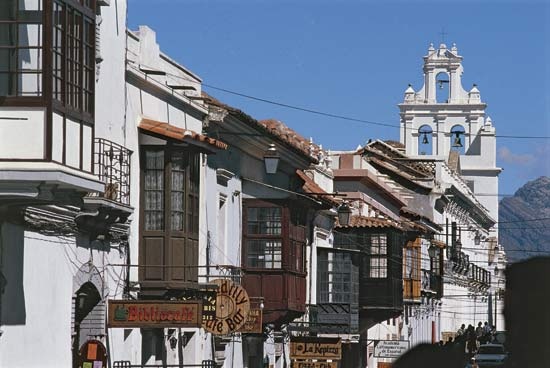Sucre
Bolivia
 judicial capital of Bolivia. ( La Paz is the country's administrative capital.) Sucre lies in a fertile valley crossed by the Cachimayo River 9,153 feet (2,790 metres) above sea level. It was founded in 1539 by the conquistador Pedro de Anzúrez on the site of a Charcas Indian village and has been variously called La Plata (the Spanish colonial name), Charcas, and Chuquisaca (the former indigenous name for the site, probably meaning “headquarters of the Charcas”). Many colonial churches survive, including the 17th-century Basílica Metropolitana and the churches of La Recoleta, San Lazaro, La Merced, San Miguel, and Santa Clara.
judicial capital of Bolivia. ( La Paz is the country's administrative capital.) Sucre lies in a fertile valley crossed by the Cachimayo River 9,153 feet (2,790 metres) above sea level. It was founded in 1539 by the conquistador Pedro de Anzúrez on the site of a Charcas Indian village and has been variously called La Plata (the Spanish colonial name), Charcas, and Chuquisaca (the former indigenous name for the site, probably meaning “headquarters of the Charcas”). Many colonial churches survive, including the 17th-century Basílica Metropolitana and the churches of La Recoleta, San Lazaro, La Merced, San Miguel, and Santa Clara.In 1561 the city became the capital of Charcas audiencia (judicial and military territory of Upper Peru) and in 1609 the seat of an archdiocese. An early (1809) revolutionary centre, the city became the capital of Bolivia in 1839. The following year it was renamed in honour of the liberator Antonio José de Sucre (Sucre, Antonio José de). In 1898 an effort to move the capital to La Paz resulted in a civil war. The outcome was a compromise: Sucre remained the capital in name and law and the seat of the Supreme Court, but the executive and legislature moved to La Paz.
Sucre is home to several museums, including the Casa de la Libertad, which displays Bolivia's Declaration of Independence; a textile museum; and a children's museum. One of the oldest universities in South America, Universidad Mayor, Real y Pontificia de San Francisco Xavier (St. Francis Xavier University), was founded in Sucre in 1624. The city contains many examples of Spanish colonial architecture and was designated a UNESCO World Heritage site in 1991.
Roads to Potosí, Cochabamba, and Santa Cruz and secondary roads to nearby valleys have made Sucre a commercial and agricultural centre of growing importance. Industrial establishments include an oil refinery and a cement plant. Extensive dinosaur tracks have been found at the cement quarry and other nearby sites. Pop. (2001) 193,876.
department, Colombia
departamento, northern Colombia, in the Caribbean coastal plain, crossed by the Cauca (Cauca River) and San Jorge rivers. Except for low hills in the north, the entire department is composed of lowlands. Cattle raising is widespread. Principal crops include rice, corn (maize), bananas, and tobacco. Shrimp trawlers operate in the Gulf of Morrosquillo. There are some cement factories. The Cartagena–Medellín highway traverses Sucre from north to south, passing through Sincelejo, the departmental capital. Area 4,215 square miles (10,917 square km). Pop. (2007 est.) 792,377.
state, Venezuela
estado (state), northeastern Venezuela, bounded north and west by the Caribbean Sea and east by the Gulf of Paria. The territory of 4,556 sq mi (11,800 sq km) is traversed by the northeastern highlands. Despite rugged terrain and excessive dryness in the west, Sucre is one of Venezuela's important agricultural states. Among leading crops are cacao, sweet potatoes, bananas, coconuts, and coffee. Fishing is important in the Caribbean, and an important seafood industry has been developed, particularly in Cumaná, the state capital and a commercial port and regional industrial centre. Sucre's mineral resources include asphalt from Lake Guanoco, salt from the Península de Araya, and gypsum from near Macuro. Pop. (2007 est.) 916,646.
- George Gordon Huntly, 1st Marquess and 6th Earl of
- George Graham
- George Grant
- George Grant Elmslie
- George Green
- George Grenfell
- George Grenville
- George Grey Barnard
- George Grossmith
- George Grosz
- George Grote
- George Hackenschmidt
- George Hadley
- George Halas
- George Harold Brown
- George Harrison Shull
- George Healy
- George, Henry
- George Henry Evans
- George Henry Falkiner Nuttall
- George Henry Lewes
- George Hepplewhite
- George Herbert
- George Herbert Hitchings
- George Herbert Mead